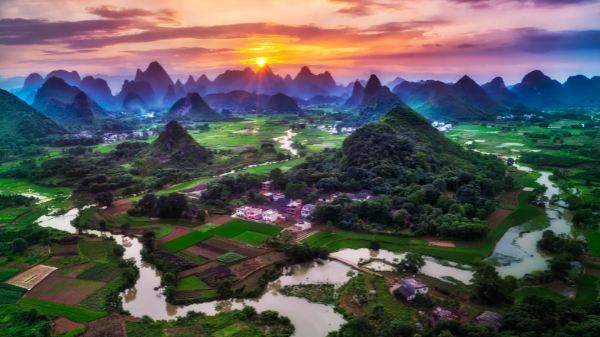The forest of sweet osmanthus trees.” This is the literal meaning behind the name of Guilin, the second-largest city in the southeastern Chinese province of Guangxi. And, if you could visit the area during the opening weeks of October, you would be greeted with a charming metropolis awash in pretty, flowering trees.
Even without this annual autumnal event, however, the city’s inherent charms, iconic jagged-peak karst mountains, verdant rice fields and meandering river landscapes have long held intrepid travellers under its thrall. This is perhaps unsurprising given the more laid-back, convivial atmosphere found here as compared to other major Chinese cities, in spite of being home to some 4.7 million residents.
Interestingly, Guilin was the first metropolis to develop a tourism industry after the founding of the People’s Republic of China in 1949, and the intervening decades have seen its stunning geography attain almost mythical status. Children’s textbooks across the country proclaimed that ‘Guilin’s landscape is the best under heaven’, and the poetic mantra of ‘By water, by mountains, most lovely Guilin’ only added to its innate allure.
But the city’s roots stretch far back; it was established by Emperor Qin Shi Huang (of Xian Terracotta Warrior fame) during the Qin Dynasty (221-206 BC). Thanks to its proximity to the Li River and its location in a fertile agricultural valley, it remained a key centre of trade and administration through the centuries.
Fast forward to the late 1900s, when modernisation and strong economic growth saw Guilin adopt all the hallmarks of a developed Chinese city, albeit with a more sedate atmosphere due to its stunning natural beauty. In spite of a sprawling urban landscape and a population of more than 1.1 million, Guilin’s natural endowments still amaze.
Thanks to this dichotomy, its most popular sites can be split into two categories. The first encompasses the many retail, dining and leisure hotspots found within its acreage. The second, unsurprisingly, reflects its jaw-dropping geographic beauty, including the surrounding majestic karst peaks. As an interesting aside, Star Wars fans may recognise these mountains as the setting for Kashyyyk, the Wookie home world in Revenge of the Sith.
Getting to Guilin was a breeze in pre-Covid times, thanks to the country’s super-efficient, high-speed railway system – the city is less than three and a half hours by bullet train from Hong Kong. More than 60 million people descended upon the metropolis in the first six months of 2019 alone, representing a 20 percent year-on-year increase. So, what exactly is there to see and do in Guilin? Read on to discover our top picks of the city’s many marvellous sights.
Li River Cruises
Cruising between Guilin and the nearby resort town of Yangshuo along the picturesque Li River is a must for any visitor. Not only does it afford the best vistas of the craggy karst towers – whose imaginative names include Green Lotus Hill, Schoolboy Hill and Snail Hill – it also transports sightseers back to simpler times.
Pass grazing water buffalo, fishermen floating atop traditional bamboo rafts, farmers working rice fields and a plethora of charming villages along the 83km (52-mile) trip.
Tour guides offer a narration of regional fables and romantic tales as you sail downstream, and some cruises even proffer local delicacies such as Sanhua wine. First wetting whistles sometime in the Southern Song Dynasty (1127-1279) or even earlier, this popular, historic tipple is distilled using rice and the pure waters of the Li.
Reed Flute Cave
Stretching beneath the southern shoulder of Guangming Hill, some five kilometres from Guilin, is Reed Flute Cave. Named for the reeds that cluster at its mouth – used to fashion traditional flutes and pipes – this 240m-deep, 500m-long cavern is home to dramatic underground karst formations: stalactites, stalagmites, stone pillars, curtains and the like. A popular tourist destination since the Tang Dynasty (618-907 AD), its modern incarnation has been fitted with walkways and coloured lights that bequeath the cave with an almost mystical appeal.
Tea Time
Every location in China boasts its own prized local tea leaves, and Guilin is no different, offering such varietals as monk fruit tea, osmanthus flower tea, Li River silver needle white tea and Longji tea. The latter is grown along the scenic Longji Rice Terraces, home to another tourist attraction in its own right – the Huangluo Red Yao Village. Home to a branch of the Yao ethnic tribe, it holds the Guinness World Record for the number of inhabitants sporting startlingly long hair – some women boast manes measuring more than two metres in length.
Back to tea and the Guilin Tea Research Institute, located just to the northeast of the city, draws a crowd thirsting for knowledge of their daily drink. Spread across plantations of some 100 acres, the site is home to a staggering 250 varietals and produces 42 tonnes of tea leaves annually. Here, connoisseurs not only learn the differences between the various prized shrubs, but also how tea is picked, processed and brewed.
Sun and Moon Pagodas
While Guilin is famed first and foremost for the spectacular beauty of its environs, the city itself is not lacking in memorable sights. Take, for instance, the Sun and Moon Pagodas, two Buddhist pavilions that rise from the waters of Lake Shanhu. Perhaps Guilin’s most instantly recognisable man-made landmark, the former is the world’s tallest bronze pagoda, rising up to 41m, while the marble monolith of the Moon Tower tops out at 35m.
Originally erected during the Tang Dynasty, the pagodas were carefully reconstructed in 2001 using historical records and are connected by an underwater tunnel – giving visitors a unique view of the lake. By night, they are illuminated by a kaleidoscope of lights that form unique geometric patterns, punctuating the exteriors and interiors in sharp relief. Unsurprisingly, this is one of the city’s most photogenic sights, surely second only to those unforgettable karsts.










